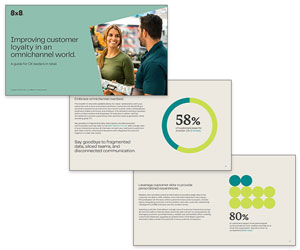Jeremy Watkin at 8×8 shares his advice for extending quality assurance (QA) across written channels.
There are major similarities and differences across all channels which can make it a bit daunting to develop the right contact centre-wide QA programme.
With this in mind, here are five of the most important things to consider when establishing a QA programme for written customer service – including channels like live chat, email and social.
1. Can a Great Phone Agent Also Handle Written Customer Service?
Regardless of the channel, great customer service involves a strong sense of ownership, problem solving, and the ability to connect with other humans.
With written communication, the ability to communicate with our voice goes out the window to an extent.
As a customer service leader, I recognized that written channels required different skills and adjusted our hiring process to screen for writing ability, typing speed, and accuracy.
Keep in mind that a big driver for offering channels like chat and SMS is the fact that agents can handle more than one conversation at a time. This equates to lower cost per contact and savings for the organization, making the ability to write efficiently all the more important.
Going back to the original question, yes it’s entirely possible that a great phone agent can also handle written channels, but it’s important to recognize that different skills are required.
2. Can We Just Replace the Word “Phone” with “Email, Chat, etc” on Our Quality Form?
As you will see in my post titled Building a Game-Changing Quality Form, I’m a big proponent of building a simple quality form that evaluates the skills and behaviours that span all customer service channels.
Skills like accurate information, communication, compliance, and the ability to connect with the customer are universal across all channels.
You may not have to reinvent the wheel for each channel. If you already have a quality form for your phone channel, it’s possible that many of those skills can be translated to written channels by creating a quality definition document that goes into more depth on how the skills translate for each channel.
For example, when evaluating an agent’s communication skills on the phone you might listen to their tone of voice, pace of speech, and the presence of long pauses and filler words.
For written channels, communication skills will include grammar, spelling, and the ability to write consistently with branding guidelines.
3. How Does Security Differ for Written Channels Versus Spoken?
Security is always an important consideration. For example, when authenticating a customer over the phone, many companies require customers to verify multiple pieces of information before discussing their account.
For written channels, customers are often required to log in with 2-factor authentication before sending a message to customer service. Or perhaps we’re talking about social media and the conversation must be moved to a private channel before any account information is discussed.
Also consider the handling of payment information. A solution like 8×8 SecurePay allows agents to securely process payments over the phone.
When it comes to written channels, however, what happens if a customer accidentally shares their credit card number in a chat or email rather than entering it securely on a website?
The best practice is for contact centre agents not to handle payments for customers but to instead direct them to secure locations to enter that information. You can see that the processes may differ by channel, however.
4. What Constitutes a Reviewable Interaction?
There are a couple of terms that are especially helpful in answering this question.
They are synchronous and asynchronous communication. Similar to the term “live channel,” phone and most chat are considered synchronous communication channels because there’s a defined start and end to the conversation with an agent and customer conversing back and forth.
Asynchronous communication, on the other hand, behaves more like an email or text conversation where threads can be closed and reopened and handled by more than one person, typically over a longer course of time.
There are two reasons this is important. First of all, when selecting an interaction to review – let’s say an email – scoring one message to the customer may or may not constitute a complete interaction.
It’s important to evaluate the entire thread, not just one message.
Taking this a step further, there are many occasions in the modern contact centre where a customer interaction spans multiple channels. For example, a customer contacts Support on Twitter, then sends a direct message with their phone number, and the interaction concludes with a phone call from an agent.
Another common scenario occurs when a customer interaction with an agent begins on a synchronous channel (phone call or chat) and then the agent sends follow-up information via email.
The entirety of these interactions should be evaluated and the quality form should be designed to support this.
5. Do We Need to Evaluate Quality If We’re Using Canned Responses?
Also called macros or templates, canned responses are pre-written responses to common questions, and they are both good and bad.
On the positive side, they save time so agents don’t have to freehand the same message over and over again, they ensure that consistent information is sent to customers, and help newer agents communicate with customers faster.
On the negative side, canned responses can become a crutch for contact centre agents where they will quickly select the closest thing to a correct answer and hit send.
There’s nothing more aggravating to a customer than receiving a response that only partially addresses the issue and sounds like it was written by a robot.
Should you be using macros at all? Absolutely! But it’s important to use them as tools to more efficiently craft the perfect personalized response to a customer. And it is important for quality assurance to pay careful attention to ensure agents aren’t taking the easy route if it’s not appropriate.
Conclusion – Don’t Reinvent the Wheel
As you look to evaluate the quality of written customer interaction channels in your contact centre, there’s no need to reinvent the wheel. I recommend adopting a simple quality form that can be used for more than one channel.

Jeremy Watkin
Build a process that recognizes that customers might interact with a company on more than one channel and through a series of messages to get their issue resolved.
Finally, take the time to define what top-quality customer service looks like for each written channel and you’ll ensure a consistent experience for your customers regardless of the channel they choose.
Author: Robyn Coppell
Published On: 14th Jul 2020 - Last modified: 15th Jul 2020
Read more about - Guest Blogs, 8x8

















